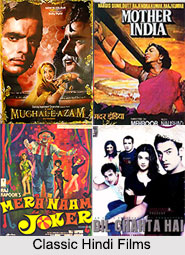 Films produced by the Hindi film industry, globally famed as Bollywood, have paved their way to becoming cult classics, with the efflux of time. Many of such classic Hindi films lay bare the characteristic Indian spirit and flavour. There is no dearth of classic Hindi films in Indian cinema. While some of them were inspired from literature, others were costume dramas. As time passed by, more classic Hindi films based on original scripts came into being. This time they were either simple love stories or revenge tragedies and even social dramas, where heroes did not spring up from novels or historical tales. The protagonists seemed more real as the films began to portray the life of the common man.
Films produced by the Hindi film industry, globally famed as Bollywood, have paved their way to becoming cult classics, with the efflux of time. Many of such classic Hindi films lay bare the characteristic Indian spirit and flavour. There is no dearth of classic Hindi films in Indian cinema. While some of them were inspired from literature, others were costume dramas. As time passed by, more classic Hindi films based on original scripts came into being. This time they were either simple love stories or revenge tragedies and even social dramas, where heroes did not spring up from novels or historical tales. The protagonists seemed more real as the films began to portray the life of the common man.One of the earliest classic Hindi films was Bimal Roy's ‘Devdas’ (1955). The film was inspired from Sarat Chandra Chatterjee's Bengali novel of the same name. The film featured the legendary Dilip Kumar in the titular role, alongside Vyjayanthimala and Suchitra Sen in the lead. Post ‘Devdas’ came noted films like ‘Kismet’, ‘Andaz’, ‘Mahal’ and ‘Barsaat’. In the 1940s and 50s, actors Ashok Kumar, Raj Kapoor, Dilip Kumar, Nargis, Madhubala amongst others were the stars onscreen. Bimal Roy's ‘Do Bigha Zamin’ (1953) transformed the way Hindi films presented its heroes and heroines. For the first time had Hindi films come up with a subject that dealt with common man. Raj Kapoor's ‘Shree 420’ (1955) and Mehboob Khan's ‘Mother India’ (1957) were the noted films of the late 50s that are regarded classics. There are also cult films of Guru Dutt, namely ‘Pyaasa’, ‘Kaagaz Ke Phool’, ‘Chaudhvin Ka Chand’ and ‘Sahib Bibi Aur Ghulam’. The period also witnessed the release of ‘Sujata’ which catered the rise of a new star on the horizon of Hindi films, Nutan. Films like ‘Sujata’ and ‘Bandini’ catapulted her to immense success.
The 1960s continued the Golden Era with more classic Hindi films. ‘Mughal-e-Azam’ (1960) depicted an epic historical drama following the love affair between Mughal Prince Salim, who went on to become Emperor Jahangir, and Anarkali, a court dancer. Salim's father, Emperor Akbar, disapproves of the relationship and this leads to a war between father and son. The opulent sets, incredible performances and the enchanting chemistry between Madhubala and Dilip Kumar swept the audiences of their feet. The haunting melodies of this classic have continued through ages, just as the charm and appeal of the film amongst the masses today. Subsequent releases included ‘Sangam’, ‘Aradhana’, ‘Padosan’, ‘Ram Aur Shyam’, ‘Waqt’, ‘Mera Saaya’, ‘Junglee’ and others.
Raj Kapoor's ‘Mera Naam Joker’ and Meena Kumari's ‘Pakeezah’ released in the 1970s. Rajesh Khanna was the megastar of this period. Dev Anand's ‘Hare Ram Hare Krishna’ introduced Zeenat Aman, a brilliant female actor and style icon. The later half of the 1970s witnessed the rise of another superstar who went on to rule the Hindi film industry for years to come. Amitabh Bachchan came into public glare as the angry young man with ‘Zanjeer’ (1973). What followed was a string of hit films like ‘Deewar’, ‘Sholay’, ‘Namak Haraam’, ‘Mr. Natwarlal’, ‘Namak Halaal’, ‘Abhimaan’ and several others. ‘Sholay’ is still considered one of the most successful films in the history of Indian cinema. After over 4 decades of its release, it is regarded as the greatest film made in the last 50 years.
For more, visit the link below:
https://www.indianetzone.com/34/classic_hindi_films_indian_movies.htm
https://www.indianetzone.com/34/classic_hindi_films_indian_movies.htm